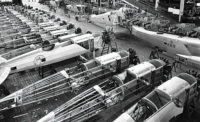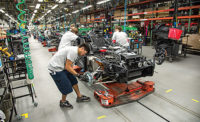Think all big trucks look the same? Don’t tell that to an engineer at Kenworth Truck Co. The legendary firm is synonymous with hard-working, well-built vehicles.
After withstanding a sluggish period in the cyclical truck industry, the 90-year-old company is on a charge. Just in time to meet an uptick in market demand, it recently launched two innovative models. Both trucks are built in Chillicothe, OH.
Thanks to recent investments in robotics technology and a healthy dose of lean manufacturing initiatives, Kenworth Chillicothe, a division of Paccar Inc., is one of the most efficient assembly plants in the Class 8 truck industry.
Heavy-duty trucks built at the 500,000-square-foot factory include aerodynamic models with sleeper cabins for over-the-road, long-haul applications and vocational models for tough applications, such as dump trucks and concrete mixers.
Kenworth Chillicothe also assembles trucks used for short-haul deliveries and classic models with numerous chrome and customization options. In addition, the plant builds off-highway models equipped with six-wheel-drive and dual-front steer axles.
Customization is part of Kenworth’s DNA. No two trucks rolling down the assembly line are exactly alike. Customers choose from among thousands of options that go beyond just variations in engines, fuel tanks, axles, transmissions and suspensions. Trucks can be equipped with all sorts of day-cab and sleeper-cab configurations. In addition, numerous electronic device options for navigation, diagnostics and communication add to assembly mix and complexity.
“Our business model is engineer-to-order,” says Scott Blue, plant manager. “Every order is customer-specific. Our business system and supply chain are tuned to provide the shortest time to market. Therefore, increasing our plant capacity to produce more units on a single shift has a very positive effect by providing customers with a shorter lead time from ordering to receiving the finished truck.”
Kenworth encourages customers to visit the Chillicothe plant, and its sister operation in Renton, WA, to see their trucks being built. “In fact, we encourage visitors to talk directly with [assemblers],” adds Blue. “We want our customers to know face-to-face how important it is for us to have their orders and their trust that we will build their truck to their satisfaction with the highest quality. We all appreciate the fact that as long as our customers stay in business, then we stay in business, too.
“Some of the original employees from when the plant first opened are still proudly supporting our customers,” Blue points out. “However, production capacity in the plant has been expanded by more than 400 percent from 1973 to 2013.”
Kenworth’s focus on customers is paying off. Last year, the company achieved a record 15 percent market share in Class 8 retail sales for the United States and Canada. And, Kenworth consistently ranks highest in the J.D. Power and Associates’ annual customer satisfaction studies.
Rather than rest on its laurels, however, Kenworth has invested heavily in new product development. For instance, it recently unveiled two new trucks that set the industry standard. The aerodynamic T680 debuted last year, while the innovative T880 vocational truck will launch this year. Both are assembled exclusively at the Chillicothe plant.
The T680 is Kenworth’s most aerodynamic truck ever. It features a wider cab and wider door opening for easier entrance and exit. In addition, the number of fasteners used to install interior cab trim components was simplified from more than 120 different fasteners to less than 40, reducing assembly complexity and cost.
New Tools and Technology
Kenworth Chillicothe invested millions of dollars in new equipment to produce the new trucks. For instance, a state-of-the-art robotic cell assembles aluminum cabs.
The flexible system employs more than a dozen robots to fully assemble T680 and T880 cabs. Robots automatically change multiple heads as they install self-piercing rivets during panel assembly.
Subassemblies are shuttled into location from station to station through automatic material handling queues. Robots apply waterproofing sealant and remove drilling debris out of the cabs with a vacuum.
Radio frequency identification (RFID) technology is used to locate and move product from beginning to end. Noncontact measuring equipment provides real-time dimensional feedback for accuracy and programming improvements.
“We added 16 robots to the body build and the windshield set processes,” says Lex Tisdale, manufacturing engineering manager. “A combination of six-axis and seven-axis robots are used, with varying payload capacities up to 1,320 pounds. A vision system measures and validates dimensions on the body build cell, and we are using vision systems for super accurate placement of the windshield into the cab opening.
“The new system is highly repeatable, with a dimensional control of 0.25 millimeter,” adds Tisdale. “The automated cell minimizes labor, but also increases the repeatability of the job functions.” It now takes 56 percent less time to assemble day cabs and 41 percent less time to assemble sleeper cabs.
Kenworth engineers also installed a robotic cell for fuel tank assembly. “The benefits are improved quality, reduced damage, reduced cycle times and lower manufacturing costs,” says Tisdale.
The cell consists of seven six-axis robots with material handling and MIG welding capability. The robots have varying payload capacities up to 360 pounds. Two vision systems are used for seam tracking and part recognition.
A material handling robot moves each fuel tank from the input conveyor into the welding station. Because tanks are built in many lengths and fuel capacities, the system automatically adjusts for different part sizes. Two more robotic arms weld the end caps.
The finished tank is moved by a material-handling robot to the next station, where fittings are attached. A vision system locates the fitting positions. One robot retrieves the fittings and holds them in place, while another robot welds them to the tank. After welding, the material-handling robot moves the tank into the pressure test and plumbing area.
“The new system is highly repeatable,” says Tisdale. “Welding thin-skin aluminum accurately with an aesthetically pleasing look is a very challenging task for a robotic application. While it took time after launch to optimize this cell, it has proven to be a huge asset to our product quality.”
The average fuel tank now takes around 25 percent less time to produce vs. the old manual assembly process. However, production efficiency is typically doubled, because most trucks have two fuel tanks.
Several other new assembly techniques developed for the T680 will benefit how other Kenworth trucks are made in the future. For instance, prior to the T680, waterproof urethane was applied robotically before the windshield was installed. This installation process made it easier for the windshield to be replaced later during service.
“We asked the design engineers to come up with a quick-drying urethane adhesive that would make the T680 windshield leak-free and could also be used on other Kenworth vehicles,” says Tisdale. “The process ultimately resulted in a one-piece bonded-in panoramic windshield for the T680 that offers a leak-free design, a 27-degree rake angle for improved aerodynamics, and thicker glass for greater chip resistance. We also found that the T680’s windshield takes about a quarter of the time to replace.”
Despite the recent investment in robotics, people continue to play a critical role in Kenworth Chillicothe’s success. “Our employees at all levels provide the ideas and put in the effort to continuously improve our processes, so that we can meet or exceed our customer’s expectations with every single truck we build,” says Blue.
Operator input is key to the successful implementation of all new assembly strategies and continuous process improvements. Input occurs in a variety of ways.
“Operators can easily enter ideas into the employee suggestion link on every computer throughout the facility,” notes Blue. “Small improvements can be made every day. Every week, the sharing of best-practices with other plants is facilitated through weekly improvement presentations for all to see. Employees can also participate as team members in process improvement events using structured Six Sigma tools and methodologies. Open and continuous communication is also facilitated through daily team meetings.”
Safety also plays a crucial role in the daily success of Kenworth Chillicothe. “Safety is first in everything we do,” says Blue. “We track and publish safety improvement goals as performance metrics for all employees to see, including plant improvement goals vs. industry standards for OSHA recordable and lost time injury rates.”
Kenworth Chillicothe also focuses on continuously improving ergonomics on the assembly line. “Ergonomics are taken into consideration during capital project planning and when improving current production processes,” says Blue. “For example, when developing a new hanging conveyor system in frame assembly, the optimal ergonomic working heights were incorporated into the design to aid assemblers.”
In the axle assembly department, a battery power source was added to a mobile suspension lift cart. The carts are used to lift large springs into place on the axle trim line. The original cart contained a manual foot pump. A battery pump is now used to lift the springs.
In addition, the materials department uses established maximum recommended lift weights to correctly guide the containerization of parts. “Ergonomic improvements also apply to large shipping racks that have to be collapsed when empty,” explains Blue. “This allows more racks to fit into a container and reduces cost-per-rack on return trips.
“Our manufacturing engineers have developed an ergonomic lift assist that can be attached directly to a shipping rack,” adds Blue. “If a rack requires a lift force greater than 40 pounds to erect from a collapsed state, the lift-assist is added.”
Lean Leader
Continuous improvement activities at Kenworth Chillicothe consistently drive better margins and competitive advantage. Process flexibility is maintained through an engaged and highly skilled group of employees who are well-versed in lean manufacturing.
“Our concept of lean is a team-based method of continuous process improvement based on customer requirements,” says Joe Zitzelberger, director of manufacturing development. “Lean process improvements focus on small improvements daily. Employees work in high-powered small teams that identify and eliminate waste.”
Kenworth Chillicothe is increasingly using lean manufacturing techniques to improve material handling. For example, forklifts are being phased out and replaced by delivery trains and trams.
“The goal here is to move from a bulk line-side drop and storage, to a material pull system based on consumption,” says Zitzelberger. “To do this, we are developing part supermarket load areas, train-tram delivery systems, and standard routes to deliver kitted material line-side based on assembly needs. This transition from bulk forklift material delivery to just-in-time kits is an ongoing process prioritized by process needs, space and resources.”
In the cab build and hood trim assembly production areas, parts used to be delivered in bulk containers that were simply dropped off in stationary racks along the line. Each assembler had to walk to the rack to get the parts they needed.
“In essence, every assembler was also a material handler,” says Zitzelberger. “Line-side bulk delivery [risked] the opportunity for too many of some parts, too few of others, and undisciplined material rotation.”
Assemblers solved the problem themselves. They created a lean material flow by establishing a flow-through parts supermarket based on first-in, first-out material replenishment. The teams built and tested their own kit carts that travel on-line with the assembly process.
Parts now come to the assemblers and line-side racks have been removed. When the kit-carts are empty, it creates a visual verification that all of the correct parts have been installed.
A different type of material handling problem recently existed in the paint department at Kenworth Chillicothe. Among other things, the department must deliver more than 22 small parts, such as mirror shells, A-pillar covers and split fenders, to numerous locations along the assembly line.
In the past, forklifts delivered these parts in bulk to the line, explains Blue. However, they often delivered too much material or too little. In addition, finished parts were prone to damage due to excessive handling. As many as 20 different people might handle the parts.
To address the problem, the affected departments convened a kaizen team. “This team is still in the process of finalizing some smaller improvements to tweak the process improvement even more,” notes Blue. “But, what they have outlined so far is an astounding improvement in process quality, process assembly and material flow delivery.
“Now, instead of a bulk set-down area in the paint department, the team has created a supermarket kitting area,” Blue points out. “Instead of bulk delivery to the assembly line, kitted carts for each sequential chassis requirement have been created to deliver parts in sets.
“A train-tram delivery system, route and frequency have been established,” adds Blue. “Currently, this tram delivers parts to all of the different assembly locations every two hours, all controlled just-in-time by only one person.”










